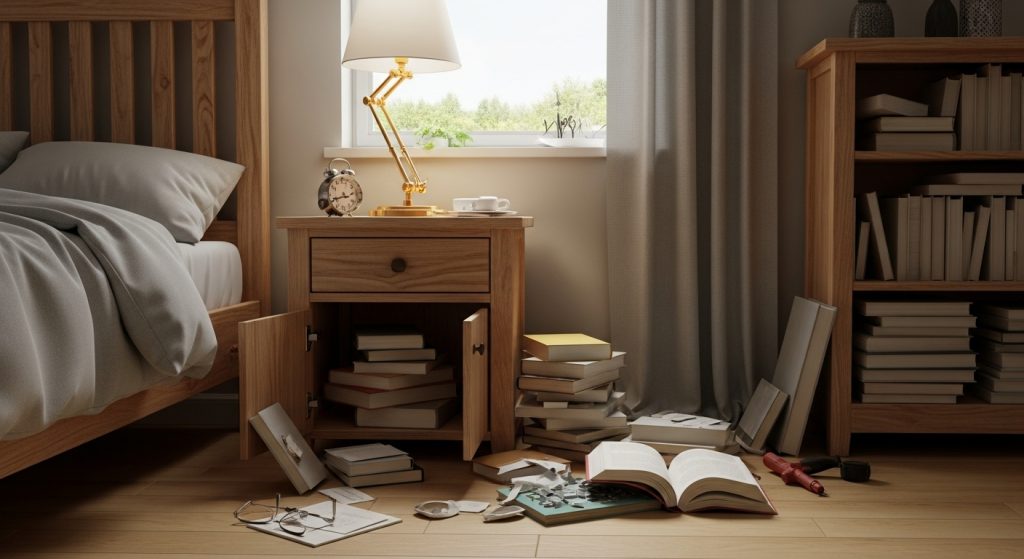Identifying the common nightstand buying mistakes to avoid is the first step towards selecting a piece that truly enhances your bedroom. A nightstand is a small but essential component of a functional and stylish sanctuary. It holds nighttime necessities and anchors the bed visually. Yet, the process of choosing one is often rushed, leading to purchases that are impractical, ill-fitting, or aesthetically jarring.

This definitive guide provides an expert analysis of the most frequent errors buyers make. It offers clear, actionable solutions derived from professional design principles. By understanding these pitfalls, you can navigate the selection process with confidence, ensuring your final choice is a perfect blend of form, function, and lasting quality.
What is the Most Common Nightstand Buying Mistake? (Ignoring Functionality)
The most common mistake is ignoring functionality, prioritizing looks over practical needs. Buyers often choose a nightstand solely for its appearance without adequately considering how much storage they require or the size needed for essential bedside items. This leads to a nightstand that looks good but fails in its primary role, resulting in clutter and inconvenience.
A nightstand’s fundamental purpose is to serve the person in bed. It should hold the items needed for comfort and convenience throughout the night. Before considering style, a thorough assessment of functional requirements is essential. This practical-first approach ensures the chosen piece actively supports your lifestyle rather than hindering it. This principle is a core part of choosing the right nightstand.
How Does Ignoring Storage Needs Lead to Clutter?
Ignoring storage needs inevitably leads to clutter. If you require space for books, medications, chargers, and personal items, but choose a nightstand with only a small surface or a single tiny drawer, those items will inevitably pile up on top or spill onto the floor. This creates visual chaos and undermines the serene atmosphere a bedroom should have.
- Solution: Honestly assess what you need to store beside your bed. Make a list. Then, choose a nightstand configuration—drawers, shelves, cabinets, or a combination—that provides adequate, appropriate storage for those specific items. Concealed storage (drawers or cabinets) is generally best for maintaining a tidy look.
Why is Assessing Surface Area Needs Crucial?
Assessing surface area is crucial because the tabletop must comfortably accommodate essential items without feeling cramped. You need sufficient space for a lamp, an alarm clock or phone, a glass of water, and perhaps eyeglasses or a book currently being read. Choosing a nightstand with a surface that is too small leads to items being precariously balanced or constantly knocked over.
- Solution: Measure the footprint of the items you absolutely must keep on the nightstand surface. Ensure the tabletop dimensions offer enough clear space for these items plus a little extra “breathing room.” Avoid the temptation to overfill the surface; less is often more for a calm bedside environment.
How Does Forgetting Your Routine Impact Choice?
Forgetting your specific nightly or morning routine can lead to choosing an impractical nightstand. Do you need easy access to a drawer for medication right before sleep? Do you charge multiple devices overnight? Do you often read in bed and need space for several books? Thinking through these routines helps identify specific functional requirements that might otherwise be overlooked.
- Solution: Before shopping, visualize your typical actions around bedtime and waking up. Note down the items you interact with most frequently. Let these real-life needs guide your selection, ensuring the nightstand’s design supports, rather than hinders, your daily habits.
How Does Incorrect Size Ruin Both Function and Style? (Getting Scale Wrong)
Choosing a nightstand of the incorrect size or scale is another major mistake. A piece that is too tall, too short, too wide, or too narrow relative to the bed will look visually awkward and feel uncomfortable to use. Proper scaling is essential for creating a harmonious and functional relationship between the bed and its adjacent furniture.
Getting the scale right is a fundamental principle of good interior design. It ensures that furniture pieces relate comfortably to each other and to the human body. A nightstand at the wrong scale disrupts this balance, creating both practical and aesthetic problems. The impact of scale on design is significant.
What Happens When the Nightstand Height is Wrong?
When the nightstand height is wrong relative to the mattress, it becomes ergonomically awkward. A nightstand that is too low requires uncomfortable reaching down, while one that is too high forces you to reach up and over. Visually, it creates a disjointed line, disrupting the sense of balance around the bed.
- Solution: Measure the height of your mattress top (including any toppers) when the bed is fully made. Choose a nightstand that is roughly level with this height, or slightly taller (up to 4 inches above). This ensures easy reachability and creates a pleasing visual connection. Our detailed guide, how tall should a nightstand be compared to your bed?, covers this crucial measurement.
How Does Width Affect Visual Balance?
The width of the nightstand affects the visual balance between the bed and the flanking tables. A very large bed paired with tiny, narrow nightstands can look disproportionate and unsatisfying. Conversely, very wide nightstands next to a small twin bed can overwhelm the space.
- Solution: Consider the width of your bed. King and California King beds generally look best with wider nightstands (24 inches or more). Twin and Full beds pair better with narrower options (under 24 inches). Ensure the chosen width also fits comfortably within the available floor space, leaving adequate clearance.
Why is Depth Important for Room Flow?
The depth of the nightstand (front to back) is important for maintaining clear pathways around the bed. A nightstand that is too deep can jut out into the room, becoming an obstacle, especially in smaller bedrooms. This impedes traffic flow and can make the room feel cramped.
- Solution: Measure the available space beside your bed. Consider the path you take to get in and out of bed or walk to a closet. Choose a nightstand depth that allows for comfortable movement, typically leaving at least 24-30 inches of clear walkway space where possible.
Why Does Falling for Looks Alone Lead to Regret? (Style Over Practicality)
Falling for a nightstand’s looks without considering its practical aspects is a common path to buyer’s remorse. A trendy, beautiful piece might catch your eye, but if it doesn’t offer the storage you need, is made from an impractical material, or doesn’t fit your lifestyle, it will ultimately be a source of frustration rather than pleasure.
Balancing style with practicality is key. A nightstand is a hard-working piece of furniture. Its ability to withstand daily use and meet your functional needs should be weighed equally with its aesthetic appeal.
How Can Trendy Styles Become Quickly Dated?
Choosing a nightstand based solely on a fleeting trend can lead to it looking dated within a few years. While incorporating current trends can be fun, the core pieces of furniture in a bedroom should ideally have a more timeless quality. Overly specific or exaggerated styles may not age well.
- Solution: Opt for nightstands with classic silhouettes and finishes that have enduring appeal. If you want to incorporate trends, do so through smaller, easily changeable accessories like lamps or decorative objects, rather than the main furniture piece itself. Focus on quality materials and craftsmanship, which are always in style.
What is the Danger of Choosing Impractical Materials?
Choosing a nightstand made from an impractical material for your lifestyle is a common mistake. For example, a delicate, unsealed wood top might be beautiful but is easily damaged by water rings from a bedside glass. A high-gloss lacquer finish looks sleek but shows every fingerprint and scratch. A mirrored nightstand requires constant cleaning.
- Solution: Consider your habits and the level of maintenance you are willing to undertake. Choose materials known for their durability and ease of care, especially for the top surface. Our guide to the best nightstand materials for durability and style explores the pros and cons of various options like solid wood, metal, and glass.
How to Balance Aesthetics with Real-Life Needs?
Balancing aesthetics with real-life needs involves being honest about how you live. If you tend to accumulate clutter, prioritize nightstands with ample concealed storage (drawers or cabinets) rather than open shelves, even if the open-shelf look appeals to you stylistically. If you have young children or pets, opt for more durable, scratch-resistant materials.
- Solution: Make a list of your non-negotiable functional requirements first. Then, filter your style choices through that list. Look for pieces that meet your practical needs and align with your aesthetic preferences. Function should inform form.
How Does Ignoring Build Quality Lead to Disappointment? (Material/Construction Quality)
Ignoring the build quality of a wooden nightstand is a mistake that leads to long-term disappointment. A piece that looks good initially but is poorly constructed will quickly show signs of wear, wobble, or even fail structurally. Assessing the quality of the materials and joinery is essential for making a lasting investment.
High-quality construction is often hidden from view, but it is the true indicator of a piece’s value and longevity. Learning to spot the signs of good craftsmanship is a key skill for any furniture buyer. This is especially true when considering things to consider before buying a wooden nightstand. The difference in lifespan between well-built and poorly built furniture is significant.
Why Should You Inspect Joinery Before Buying?
Inspecting the joinery is crucial because it reveals how the pieces of wood are connected, which determines the nightstand’s strength and stability. High-quality joinery methods like dovetails or mortise-and-tenon create strong, lasting bonds. Lower-quality methods using only staples, basic screws, or minimal glue result in weaker joints that are prone to loosening or failing over time.
- Solution: Open drawers and look at the corners. Check where legs attach to the frame. Look for signs of robust joinery. Avoid pieces where joints are clearly just stapled or rely heavily on visible glue.
How Does Drawer Construction Indicate Longevity?
Drawer construction is a key indicator of quality because drawers are high-use components. Look for drawers made from solid wood rather than flimsy particleboard. Check that the drawer bottoms are solid panels fitted into grooves, not just thin sheets stapled underneath. High-quality drawer glides (metal ball-bearing or traditional wood-on-wood) ensure smooth, reliable operation for years.
- Solution: Always open and close the drawers multiple times when evaluating a nightstand. They should glide smoothly and quietly, without sticking or wobbling excessively. Feel the weight and solidity of the drawer box itself.
What Does the Back Panel Reveal About Quality?
The back panel provides important clues about overall build quality. A high-quality nightstand will have a solid wood or thick plywood back panel that is recessed into grooves and securely fastened. This adds significant rigidity to the entire structure. Lower-quality pieces often use a thin piece of cardboard stapled to the back, offering minimal structural support and indicating cost-cutting measures.
- Solution: Whenever possible, look at the back of the nightstand. Tap on the back panel. Does it feel solid or flimsy? Is it securely attached within the frame? This simple check can be very revealing.
Why Does a Mismatched Style Create Visual Discord? (Ignoring Overall Style)
Choosing a nightstand style that clashes with the bed frame or the bedroom’s overall aesthetic creates visual discord. The nightstand should feel like a harmonious part of the room’s design story, not an awkward outlier. Ignoring the existing style context is a common mistake that disrupts the cohesive feel of the space.
Achieving a unified look does not necessarily mean everything must match perfectly. However, the different elements should relate to each other in a pleasing way through style, material, or color.
How to Ensure the Nightstand Complements the Bed Frame?
The nightstand and bed frame should have a complementary relationship. If the bed frame is rustic wood, the nightstand should echo that feel (perhaps with reclaimed wood or a distressed finish). If the bed is a sleek, modern upholstered design, choose nightstands with clean lines in compatible materials like lacquer, metal, or smooth wood.
- Solution: Consider the dominant style characteristics of your bed frame (material, shape, level of detail). Look for nightstands that share or complement these characteristics. Avoid pairings that feel completely unrelated (e.g., an ornate traditional nightstand next to a minimalist platform bed).
What is the Risk of Ignoring the Room’s Existing Palette?
Ignoring the room’s existing color palette can make the nightstand look out of place. The finish of the wood or the color of a painted nightstand should harmonize with the wall color, bedding, rugs, and other furniture in the room. Introducing a completely new and unrelated color or wood tone can disrupt the visual flow.
- Solution: Take cues from your existing color scheme. Choose a wood finish that complements the other wood tones in the room. If opting for a painted nightstand, select a color that fits within your established palette, either as a neutral or a deliberate accent color. The principles of how to blend wood console tables with neutral color palettes apply here as well.
How to Achieve Cohesion Without Perfect Matching?
Achieving cohesion without perfect matching involves finding common threads between mismatched pieces. If you choose two different nightstands, ensure they share a unifying element, such as:
- Height: Keeping both nightstands at the same height is crucial for balance.
- Material: Both could be wood, but different styles or finishes.
- Color: Both could be painted the same color, despite having different forms.
- Style Category: Both could fall within the “mid-century modern” or “farmhouse” aesthetic. Using matching lamps on top of mismatched nightstands is another effective strategy for tying the look together.
Why is Measuring Your Space Non-Negotiable? (Forgetting to Measure)
Forgetting to measure your space accurately before buying a nightstand is a simple but surprisingly common mistake that can lead to significant problems. A nightstand that doesn’t physically fit the available space or leaves inadequate clearance for movement is unusable, regardless of its style or quality. Measuring is a non-negotiable first step.
The old adage “measure twice, cut once” applies equally to furniture buying: “measure twice, buy once.” Taking a few minutes to measure accurately can save you the considerable hassle and expense of returning a piece that doesn’t fit.
What Key Measurements Must Be Taken?
Several key measurements are essential.
- Mattress Height: As discussed, measure from the floor to the top of the mattress with bedding to determine the ideal nightstand height.
- Available Width: Measure the horizontal space between the side of the bed and any adjacent wall or furniture where the nightstand will go.
- Available Depth: Measure how far the nightstand can extend out from the wall without impeding walkways or door swings.
How Does Forgetting Clearance Space Cause Problems?
Forgetting to account for clearance space is a frequent error. You need space to comfortably walk around the bed, open drawers fully, and make the bed. A nightstand crammed tightly against the wall or projecting too far into the walkway makes the room feel cramped and awkward to navigate.
- Solution: Subtract clearance space from your available width and depth measurements. Aim for at least 2-3 inches of clearance on either side of the nightstand. Ensure there is enough space in front for drawers to open fully (typically 18-24 inches). Allow for adequate walkway space around the foot of the bed (ideally 30-36 inches).
How to Visualize the Nightstand in Your Space?
Visualizing the nightstand in your space before buying can prevent scale mistakes. Use painter’s tape to mark the footprint (width and depth) of the potential nightstand on the floor. You can also stack boxes or use cardboard cutouts to simulate its height. This simple exercise helps you get a real feel for how the piece will occupy the space and interact with your bed. Many online retailers now offer augmented reality (AR) tools that allow you to virtually place furniture in your room using your smartphone camera.
Conclusion
Avoiding these common nightstand buying mistakes is the key to selecting a piece that you will be truly happy with. By prioritizing function alongside style, taking accurate measurements to ensure proper scale, carefully evaluating material quality and construction, and considering the overall aesthetic of your bedroom, you can make an informed and confident decision. A thoughtfully chosen nightstand is more than just furniture; it is an investment in your comfort, convenience, and the serene beauty of your personal sanctuary.











